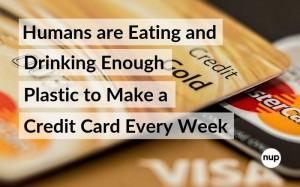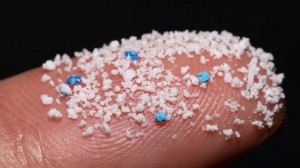From an Article by Kevin Loria, Consumer Reports, April 30, 2020
The Menace of Microplastics
Any plastic item—bag or bottle, toy or chair—starts to come apart with use and time, breaking down into tinier and tinier fragments. Most of the plastic produced hasn’t been recycled (see “What’s Gone Wrong With Recycling”). But it’s not just old plastic that has disintegrated into particles that make their way into lakes, rivers, and oceans. Cracking open a brand-new plastic bottle or tearing a wrapper off a sandwich releases fragments of plastic that we might end up ingesting. Household dust can be full of microplastics—and it’s possible that you might kick this up into the air from your carpet and breathe it in. Plastic fibers even wash off clothes into our water supplies.
Fragments of plastic smaller than 5 millimeters in length are known as “microplastics,” and scientists have started to refer to even more microscopic fragments—generally smaller than 1,000 nanometers—as “nanoplastics.” In a 2019 report, the World Health Organization found that we’ve unknowingly ingested microplastics for decades without clear negative consequences, saying that research into potential health effects is needed. While there’s much we don’t yet know, we have learned that micro- and nanoplastics are everywhere. Snow in the Arctic carries substantial amounts of microplastic, according to a 2019 study in the journal Science Advances, and even more has been detected in the Alps. Microplastics can even be found in the seemingly pristine sand of Hawaiian beaches.
Given this, researchers are concerned that these plastics can make their way into the tissues of our bodies, according to Linda Birnbaum, Ph.D., the recently retired director of the National Institute of Environmental Health Sciences (NIEHS) and the National Toxicology Program. “Nanoplastics can easily cross all kinds of barriers, whether it’s the blood-brain barrier or the placental barrier, and get into our tissues,” Birnbaum has said. Breathing in nanoplastics might introduce them into our cardiovascular system and bloodstream, for example.
It’s also possible that nanoplastic particles might create a systemic inflammatory response, according to Phoebe Stapleton, Ph.D., an assistant professor of pharmacology and toxicology at Rutgers University in New Brunswick, N.J. Her research has previously shown that inhaled metal particles can harm the cardiovascular health of a developing fetus. And her animal research has also confirmed that when a mother breathes in nanoplastics, the particles can be found in many places inside the fetus. “We know that after exposure, the plastic particles are everywhere we look,” Stapleton says. “We don’t know yet what those particles are doing once they’re deposited there.” Other researchers, like Myers at Environmental Health Sciences, are concerned that nanoplastics could possibly release harmful chemicals (such as BPA) into our bodies.
Another area of inquiry focuses on the fact that microplastics act like magnets for additional toxins, picking up pollutants such as polychlorinated biphenyls (PCBs), chemicals now banned from manufacture in the U.S. but still present in the environment. According to Linda Birnbaum, formerly at the NIEHS, if we later ingest or inhale contaminated microplastics, they may release these substances they’ve picked up into our blood or organs, along with whatever chemicals are also in the plastic itself.
(To be continued.)
###########
See also: Environmental toxicologist wants to understand how microplastics affect human health,
Stephanie Wright, Chemical & Engineering News, Volume 98, Issue 15, April 19, 2020
We are studying air particles that are a so-called health-relevant size that can enter the central and distal parts of the human lung. We are also investigating whether we can detect microplastics in human lung tissue and whether we can find any links to health outcomes.
Additionally, we are doing some in vitro studies to examine the toxicology of these particles. The big question is the relative importance of microplastics. Humans are obviously exposed to thousands, if not hundreds of thousands or millions, of particles in a cubic meter of air, so it’s vital to understand the relative proportion of microplastics within those particles and their relative potency.



{ 1 comment… read it below or add one }
Five (5) Sustainable Alternatives to Plastics
By Stuart Braun, Deutsche WelleMay. 06, 2020
1.3 billion plastic bottles are sold daily around the world. And that’s just the tip of the fossil-based plastic iceberg. Plastic preserves our food. It’s in the nylon and polyester we wear, and it protects medical staff from the coronavirus.
Petroleum-based plastics dominate the market because they’re durable, light-weight and cheap, but most of them can’t be recycled or reused.
Of the 6.3 billion tons of plastic waste produced between 1950 and 2015, only 9% was recycled. The rest of it ended up in landfills, was incinerated or, all too often, landed in the ocean.
A raft of new bioplastic innovations is starting to catch up, though. And, unlike unsustainable fossil fuels, they are derived from renewable sources.
While bioplastics have the same molecular structure as petroleum-based plastics, which take hundreds of years to decompose, research shows that biomass-based polymers are also more likely to biodegrade and break down, including in industrial compost facilities. Bioplastic proponents believe they are key to making plastic part of a circular economy.
Here’s a look at five ingredients that could make bioplastics competitive with traditional plastics.
1. Olive Pits
Countries that produce a lot of olive oil have a byproduct that can be used for plastic: olive pits. A Turkish startup called Biolive began creating a range of began creating a range of bioplastic granules created from olive seeds that result in bio-based, partially biodegradable products that can decompose in a year.
The active ingredient oleuropein found in olive seeds is an antioxidant that extends the life of the bioplastic while also hastening composting of the material into fertilizer within a year.
And since Biolive’s granules act like fossil fuel-based plastics, plastic producers can simply substitute the conventional granules without disrupting the production cycle for industrial products and food packaging.
Biolive claims that by utilizing olive oil waste, production costs are reduced by up to 90% in relation to some existing bioplastics. This is important says founder Duygu Yilmaz, since starch-based bioplastics made from corn are often more expensive than petroleum-based plastics are therefore not a viable alternative.
In 2019, award-winning Biolive was chosen to represent Turkey at the United Nations Development Programme.
2. Sunflower Hulls
Like olive seeds, the husks of sunflower seeds used for oil production is a waste product also being used to created bioplastics. And luckily, they’re in near endless supply.
The German start-up Golden Compound has created a unique Sustainable Sunflower Plastic Compound bioplastic – referred to as S²PC. It’s reinforced with sunflower hulls, which they claim are 100% recyclable.
The S²PC bioplastic is being moulded into everything from office furniture to recyclable transport and storage boxes and crates.
Golden Compound also produces a “green” bioplastic that is 100% biodegradable, GMO-free and can be fully composted at home. Products include award-winning, world-first biodegradable coffee capsules, plant pots and coffee mugs.
The German start-up attributes the success of its bioplastics to performance. “In the end, the only reason people will be willing to switch, is if it works,” Marcel Dartée, General Manager at Golden Compound, told the Plastic Today trade publication.
3. Fish Waste and Algae
The growing attempt to transform organic waste into plastic now includes fish processing refuse.
A UK initiative called MarinaTex is using fish skin and scales – 500,000 tons of which are generated annually in the UK alone – bound with red algae to make a compostable plastic alternative that can replace single-use plastics such as bakery bags and sandwich packs.
MarinaTex claims the biopolymer creates stronger packaging than a conventional plastic bag — flying in the face of perceptions that bioplastics lack strength and durability.
Lucy Hughes, who created the product in her final year at the University of Sussex, says MarinaTex’s flexibility, strength and pliability was inspired by actual fish skin and scales.
“It kind of struck me that nature can make so much from so little, so why do we need to have hundreds of man-made polymers when nature has so many already available,” she told the World Economic Forum in November.
MarinaTex, which won the 2019 James Dyson Award worth €35,000, describes its product as home compostable and says it can break down within four to six weeks.
4. Plant Sugars
While PET is one of the most recyclable fossil-based plastics it takes hundreds of years to decompose. In response, Amsterdam-based Avantium has created a revolutionary “YXY” plants-to-plastics technology that converts plant-based sugars into a new biodegradable packaging material, polyethylene furanoate or PEF.
A trial of PEF biodegradability in the natural environment is showing promising signs.
“PEF degrades much faster than PET under industrial composting conditions,” Caroline van Reedt Dortland, Director Communications at Avantium, told DW. Degrading in 250-400 days as opposed to 300-500 years is significant.
It is used as a textile, film, and has the potential to become a major player in the packaging of soft drinks, water, alcoholic beverages and fruit juices, having already collaborated with the likes of Carlsberg to create a “100% bio-based” beer bottle.
According to Hasso Pogrell of European Bioplastics, it’s even possible to ” recycle PEF together with PET, and it makes the PET recyclate perform even better than the original PET.”
5. Mushrooms
Gadget blog Gizmodo wrote back in 2015 about resilient and biodegradable fungal mycelia-based materials which, unlike oil-based plastic, “create no toxic byproducts.”
One emerging brand utilizing fungi is Reishi, a sustainable, fine mycelium leather substitute created from a woven cellular microstructure derived from mushrooms. By emulating the collagen structure of animal leathers, Reishi fine mycelium is both sustainable and versatile.
Reishi creator MycoWorks has taken the water-resistant biomaterial to the next level, promising the performance, quality and aesthetics of leather or synthetic plastic materials, but with a negative carbon footprint.
Already utilized by a selection of European luxury and footwear brands, in late 2019 $17 million (€18 million) financing was raised to help deliver commercially viable non-plastic, non-animal Reishi materials to the market.
In terms of limiting fossil-based plastic consumption, the biomaterial aims to outperform existing “vegan leathers” that are created with unsustainable plastics.
https://www.ecowatch.com/5-sustainable-alternatives-to-plastics-2645932261.html?rebelltitem=1#rebelltitem1